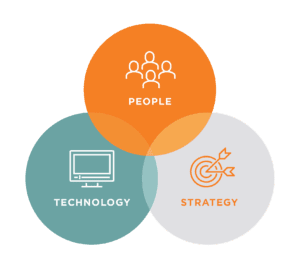
The 3 Pillars of Online Community Engagement
Online community engagement is an ongoing process – but your efforts have to start with a solid foundation. Do you have those pillars in place?
We all want more engagement in our online communities. We all want our communities to be essential parts of our users’ lives. An engaged online community can transform how an organization connects and communicates with customers, members, and employees across every stage of their journey.
But engagement isn’t instant or automatic when you launch an online community. Getting your community members to come, stay, and return is a journey and one that relies on a solid foundation.
If your community isn’t as engaged as you’d like it to be, or you’d like to know how to create a community at your organization, you should start with this question: Do you have the right pillars in place to create an engaging online community?

It all comes down to these three foundational elements:
1. The Strategy – Thinking Like Your Users
2. The People – Assigning Ownership and Community Management
3. The Technology – Choosing Your Online Community Platform
Let’s dive in.
The Strategy: Developing the Right Mindset Around Online Community Engagement
Thriving communities create generative value because of sustained engagement – users coming, going, and returning. But when you’re starting out, or you’re working your way up from good to great, it’s tough to know if you have an online community engagement strategy that will create this habit in your users. Will it stand up to uncertainty in markets, new business goals, or the changing priorities of your members, customers, and employees?
Want to dig deeper? Check out our complete guide to online community.
The Community Roundtable’s research has shown shared characteristics of advanced online communities, which require community leaders to take certain actions behind the scenes:
- Share the community strategy early and often, so it’s fully discussed, vetted, and approved
- Identify clear, actionable metrics
- Secure resources across multiple dimensions: technical, strategy, and user needs
- Charge the identified resources with accountability and authority needed to realize strategic goals
- Get commitment to a dedicated community budget
Once you’ve set the stage, it’s vital to put the community users front-and-center of your strategy.
Online community platforms can increasingly help provide a curated experience. We’ll get into the necessary technological pieces for that later, but we first have to understand some of the drivers at play with our members, customers, or employees.
That knowledge will inform our strategy on how to increase community engagement. In the next few sections, we’ll dig into how we can deliver a community engagement strategy that fits them, fits us, and builds shared success.
- What motivates them to join the community?
- Why return or why stay longer?
What motivates my users to join the community?
This question should be top of mind when you connect with new users. We know in general that communities create access – a gateway to a destination that’s shaped to their needs. We know that newcomers commonly cite a need to network with their peers, connect with experts, or to receive specialized content.
As you form your approach, keep these three pillars in mind: Find, connect, collaborate.
Once your user finds the community, is it easy for them to get involved and collaborate? Once they’re there, they should have many touchpoints for getting involved and contributing. So it’s all about building a destination that’s designed for them to engage. Think through these questions as you build your community engagement approach:
- How will you make it human-focused so it’s about the users’ needs on any given day?
- What is in place to make them feel like they have a voice?
- Have you created centralized, topic-based areas for users to get what they need?
- How will you convey value via calls-to-action (CTA) in an easy to understand way?
Why should my users return or stay longer?
A lot of energy goes into acquiring each new user. And you need them, but our experience has shown the benefits of taking a balanced strategy that includes a focus on sustained community engagement tactics.
A user may come to your online community for any number of reasons, and they may return or stay for different reasons. This, we recognize is a puzzle, but you want to create a wide enough set of opportunities for them to continuously engage. Their return and longevity signals value for your users which translates to growth for your organization.
6 Ways to Encourage Sustained Online Community Engagement
Think about self-sustaining approaches that increase the ‘stickiness’ of your community, like these:
- Identify and encourage champions. They build their reputation by sharing their expertise, which will benefit other members and the community as a whole.
- Create listening posts. Build in opportunities for feedback that don’t just come via email or surveys. Crowdsourced insights are often more valuable.
- Consider their journey and how they would interact with your community. You don’t want them to have to jump through hoops to get to a single topic or action. That can make for quick attrition.
- Organize your community around topics, built for users’ roles, interests, and even the actions they wish to take to create more relevant engagement opportunities and personalize the experience to a much greater effect. If done well, this can lead to higher satisfaction, and ultimately, more renewals and retention.
- Connect other programs to your online community, like events, webinars, or product research. Users don’t view their vendors as segmented departments, so the community should reflect that central point of truth and engagement, even as each department benefits from the full breadth of engagement.
- Personalize for users. Whenever possible, personalize with the intention of reducing “noise.” Users obviously like to have elements of the community speak to them in a way that’s relevant, but they also don’t want to be overwhelmed. Avoid community churn by curating content for different types of users.
The People: Ensuring You Have Great Community Management
Every organization needs at least some dedicated management for their community. This is one common reason a community will flounder – lack of active management. Communities need somebody to take care of them.
That being said, most small organizations don’t need a full-time community manager. But a large organization with a lot of customers, members, or users most likely will. Community management can also be a part-time position that could be taken on by someone at your organization.
The bottom line is this: It’s less about the number of hours, as it is about the experience level of the person who’s managing the community. For example, a person with more experience will need fewer hours to be highly effective, while someone with less experience will have to spend more time learning and executing effectively. Ultimately, what you need is someone with a specific skillset, and to do it well, additional capabilities.
We’ve seen that in our own customer base, as those who use our paid community management service see much higher engagement.
Customers who rely on Higher Logic’s Strategic Services during their first 12 months have:
- 68% more active users than those that don’t utilize our team
- 64% more content consumed than those that don’t utilize our team
- 102% more content created than those that don’t utilize our team
This is a good indicator that dedicated community management is an essential. If you opt to hire a community manager, these tips will help:
- Finding the right community manager
- Qualifications for a good community manager
Finding the Right Community Manager
Community management is a profession that’s evolved rapidly into one that requires a sophisticated combination of analytical skills, project management, strategy, and business acumen. And that’s on top of needing to be engaging, write well, understand the technology, and stay calm in a crisis.
What it comes down to, no matter the situation, is accountability. You’ll need someone to keep your community going, tend to it, create engagement. What you put into your online community engagement tactics is what you will get out.
5 Qualifications for a Good Community Manager
- Calm, cool, and collected. Communities will have their share of needs, often enjoyable, but often stressful. Your manager should not only set and moderate the policies of your community, but they should also gracefully navigate group dynamics.
- Change agent. Find someone who can navigate internal constraints, goals, and organizational structures so they can tap into vast areas of organic growth and user-led advocacy.
- Connector not just networker. Your manager should easily engage with your users, not just at a chatty level, but with the mission of the community and goals of your organization in mind.
- Professional engager. Look for someone who knows how to be open online but understands the legal and ethical constraints of the profession (and how your community users might feel too).
- Analytical storyteller. You need someone who can crunch the numbers, but what’s harder to find, is someone who knows how to tell a story with the data. A thinker, not just a doer.
The Technology: Finding a Community Platform That’s Built for Engagement
The modernization of community engagement software space is skyrocketing. Community management as a profession is powered by technology, so we have to look at the implementation of your tech as a change project initiative. Think about your tech stack as the foundation upon which you’ll build the destination that supports all your users’ “must-haves.”
It’s worth repeating: The technology needs to serve your member, customer or employee selection criteria – first. Yes, your needs count too, but making them happy will go a long way toward your success.
You’ve probably googled best practices and community website ideas, read case studies, and heard many sales presentations. We have too, and we’ve also been hands-on working with a lot of different kinds and sizes of organizations to onboard engagement software. To us, it comes down to three things: Alignment, Capability, and Support.
- Alignment: Why can’t I just use …?
- Capability: What functionality do I really need?
- Support: What else do I need?
Alignment: Why can’t I just use … ?
There are lots of ways to interact with your members, customers, and employees: industry events, advisory councils, webinars, social media platforms, visiting them at holidays. Ok, probably not the last one. But, not social media either.
For real, community engagement to happen, users need to feel a high degree of comfort about their privacy, asking questions, and belonging to the space. Sharing and showcasing their expertise often gets diffused on social media platforms or open source solutions.
To Accomplish Your Community Engagement Goals, Go Big
Think bigger than a support portal or forum or a listserv. Find a solution that can work with your vision of creating an engagement destination that people want to come to and return. We recommend using a proprietary community platform, for several reasons:
More control
If you create your community on social media or open source solution, you’re subject to any and all of their changes, with no say, effectively building your house on rented land.
More security
Community vendors place privacy as top priority – it’s their job. With a Facebook or LinkedIn Group, you have a limited ability to protect your members’ privacy and your own information.
More data
On a social media platform, those companies gain invaluable data that your community will inevitably generate about your members and customers – you do not. If you create your own online community, you’ll have access to all that data, helping you understand your users and creating a curated experience for your users.
More community management tools
With a community platform like Higher Logic’s, engagement tools are built in, specifically designed to help you create an engaging experience.
Capability: What functionality do I really need?
If you want an engaged community, you need to build your community in the right place. When you can motivate members, customers, and employees to consistently engage in the community, you impact key experience metrics. The technological infrastructure of your community can help your organization achieve higher productivity, deliver more innovative products and services, and improve loyalty in your userbase.
9 Questions to Help You Choose the Best Online Community Platform
- Can the platform support your goals? Can the platform support multiple use cases?
- Does it have the functionality needed to accomplish the use case you need?
- Is it easy to customize the platform and brand it? Does engagement come naturally?
- What built in tools exist to make it engaging?
- Are there community integrations with your user database? This could be a Customer Relationship Management system like Salesforce or Oracle, or it could be an Association Management System like iMIS or YourMembership.
- Can the platform provide a personalized experience for users?
- Is the vendor innovative and forward-thinking?
- Do they offer any services to help you launch your community or staff it with a community manager until you can hire one?
- Do they provide tools for measuring online community engagement?
Support: What else do I need?
When you get into segmenting users, building subgroups, creating advocate campaigns, building programs, and all the other best practices that permeate successful communities, you’ll have a better idea of which online community platform will work best for your branded community.
Read our eBook: How to Get More Engagement in Your Online Community to be inundated (in a good way) with advice on how to keep cranking up your engagement levels. You’ll see tips, case studies, checklists, and more – but there’s no magic wand. Yet. So stick to these three, solid pillars for building an engaging community destination.


